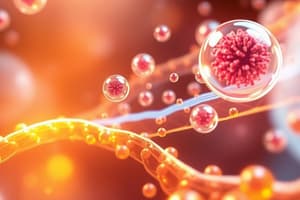Podcast
Questions and Answers
What is an energy storage molecule?
What is an energy storage molecule?
- A molecule that cannot store energy
- A molecule that is found only in animals
- A molecule that only plants can use
- A molecule that organisms can use to release the energy needed to survive (correct)
What defines an ecosystem?
What defines an ecosystem?
All the living and nonliving things interacting in a particular area.
What is a system in the biological context?
What is a system in the biological context?
A set of interacting parts forming a complex whole.
What does 'biotic' refer to?
What does 'biotic' refer to?
What does 'abiotic' refer to?
What does 'abiotic' refer to?
What is a producer?
What is a producer?
What is a consumer?
What is a consumer?
What is photosynthesis?
What is photosynthesis?
What is the word formula for photosynthesis?
What is the word formula for photosynthesis?
What are examples of energy storage molecules?
What are examples of energy storage molecules?
What are the similarities among energy storage molecules?
What are the similarities among energy storage molecules?
What are the differences among energy storage molecules?
What are the differences among energy storage molecules?
What type of atom is carbon?
What type of atom is carbon?
What is the relationship between carbon dioxide and abiotic matter?
What is the relationship between carbon dioxide and abiotic matter?
How does carbon relate to energy storage molecules?
How does carbon relate to energy storage molecules?
What occurs during the process of photosynthesis?
What occurs during the process of photosynthesis?
What happens if one part of a system changes?
What happens if one part of a system changes?
What is the effect of increased carbon in abiotic matter?
What is the effect of increased carbon in abiotic matter?
What happens when there is less carbon in abiotic matter?
What happens when there is less carbon in abiotic matter?
What happens when there is more sunlight?
What happens when there is more sunlight?
What happens when there is less sunlight?
What happens when there is less sunlight?
What are decomposers?
What are decomposers?
Where does carbon dioxide end up in an ecosystem?
Where does carbon dioxide end up in an ecosystem?
What is cellular respiration?
What is cellular respiration?
What is the word formula for cellular respiration?
What is the word formula for cellular respiration?
What is the relationship between photosynthesis and cellular respiration?
What is the relationship between photosynthesis and cellular respiration?
What happens as organisms release energy during cellular respiration?
What happens as organisms release energy during cellular respiration?
What does 'connect' mean?
What does 'connect' mean?
Flashcards are hidden until you start studying
Study Notes
Energy Storage Molecule
- Molecules that organisms use to release energy for survival.
Ecosystem
- Comprises all living (biotic) and nonliving (abiotic) components in a specific area, interacting with one another.
System
- A collection of interacting parts that form a complex whole.
Biotic Matter
- Includes all living and dead organisms within an ecosystem.
Abiotic Matter
- Consists of nonliving elements such as air, water, and rocks.
Producer
- Organisms capable of creating their own energy storage molecules like glucose.
Consumers
- Organisms that require consumption of other substances to obtain energy storage molecules.
Photosynthesis
- Process where plants' chloroplasts utilize sunlight, water, and carbon dioxide to create oxygen and glucose.
Photosynthesis Formula
- Carbon dioxide + Water → Glucose + Oxygen.
Examples of Energy Storage Molecules
- Key molecules include Starch, Glucose, Fat, and Glycogen.
Similarities Among Energy Storage Molecules
- Composed of carbon, hydrogen, and oxygen, all originating from producers.
Differences Among Energy Storage Molecules
- Glycogen, fats, and starch serve long-term energy storage but differ in atomic structure.
Carbon
- A fundamental atom forming both carbon dioxide and energy storage molecules.
Carbon in Matter
- Carbon exists in abiotic (carbon dioxide) and biotic (energy storage molecules) forms.
Photosynthesis and Carbon Transfer
- During photosynthesis, chloroplasts transform carbon dioxide into energy storage molecules, facilitating the movement of carbon from abiotic to biotic matter.
System Changes
- A change in one part of a system impacts the entire system's equilibrium.
Carbon Availability
- Increased carbon dioxide enhances the availability of carbon for producers, enabling more energy storage molecule production.
- Conversely, reduced carbon dioxide limits production capabilities.
Sunlight's Role in Production
- More sunlight allows producers to generate an increased amount of energy storage molecules from carbon dioxide.
- Less sunlight results in decreased energy storage molecule production.
Decomposers
- Organisms that extract energy storage molecules by breaking down dead matter, contributing to nutrient recycling.
Carbon Dioxide in Ecosystems
- Ends up as part of abiotic components, typically found in the atmosphere.
Cellular Respiration
- Process occurring in mitochondria where energy storage molecules and oxygen are converted into ATP energy, generating carbon dioxide and water as waste.
Cellular Respiration Formula
- Glucose + Oxygen → ATP energy + Carbon Dioxide + Water.
Comparisons of Photosynthesis and Cellular Respiration
- Both occur within cells; photosynthesis is exclusive to producers, while cellular respiration occurs in all organisms.
Carbon Movement During Cellular Respiration
- Energy release during cellular respiration converts biotic carbon (from energy storage molecules) into abiotic carbon (carbon dioxide).
Connection
- The act of linking two or more entities or concepts in biology, showing relationships within ecosystems and processes.
Studying That Suits You
Use AI to generate personalized quizzes and flashcards to suit your learning preferences.




